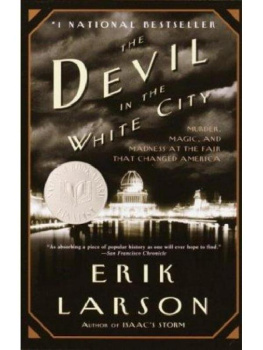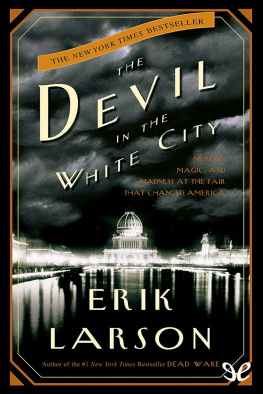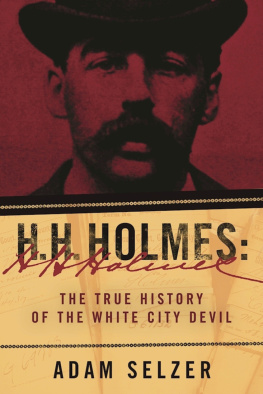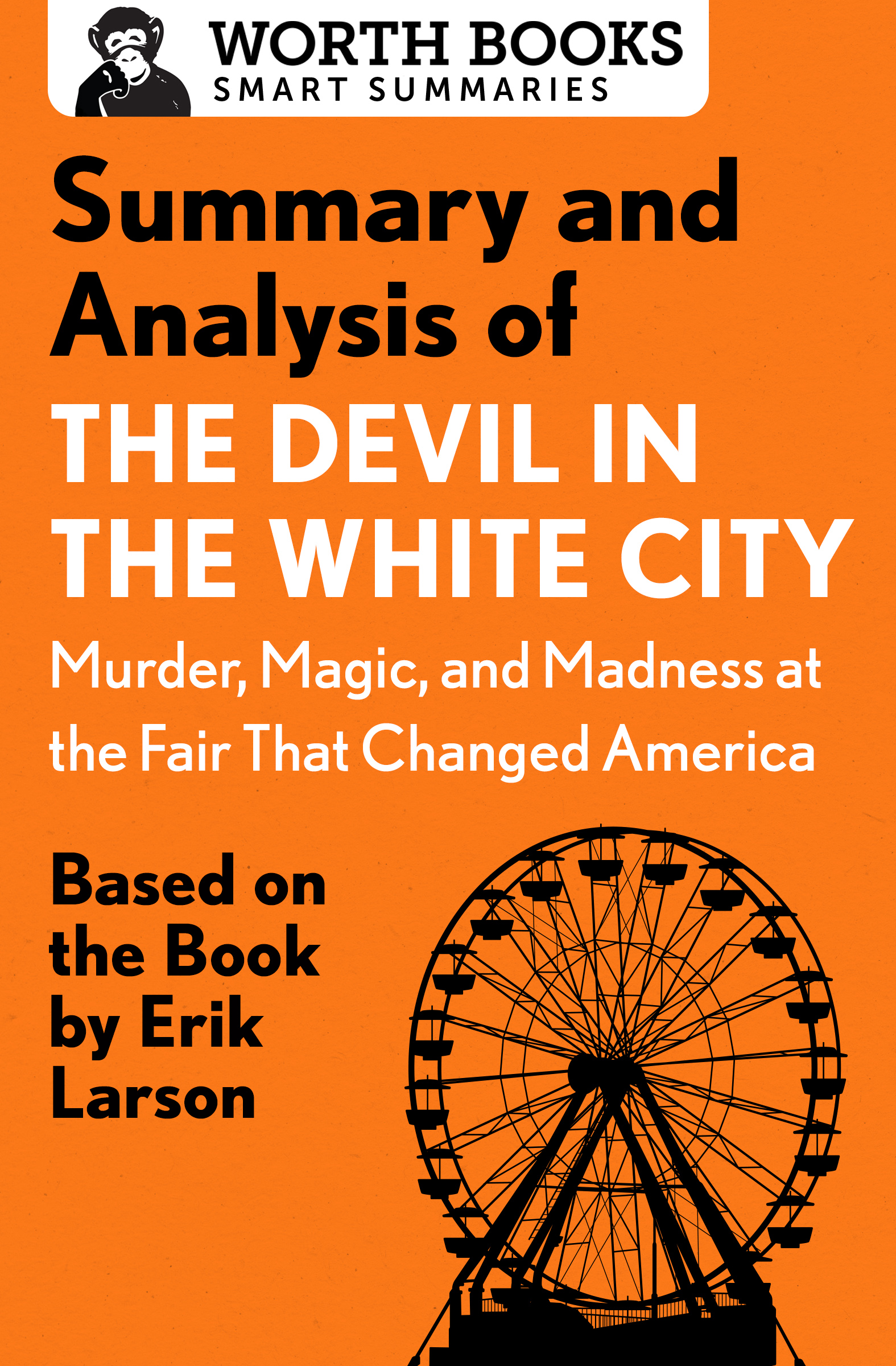Summary and Analysis of
The Devil in the White City
Murder, Magic, and Madness at the Fair That Changed America
Based on the Book by Erik Larson

Contents
Context
While much has been written about the Chicago Worlds Fair of 1893, also known as the Worlds Columbian Exposition, little has been published in modern times about the serial killer who lurked at its fringes. The Devil in the White City is the first book to juxtapose the architectural splendor and tribulation of the fairs construction with the horrific crimes and machinations of a man calling himself Dr. H. H. Holmes.
On the heels of Jack the Ripper came Dr. H. H. Holmes, the prototype of the urban serial killer. Not only was he the first known serial killer in America, he became one of the most prolific murderers in history. That Daniel H. Burnham, the architect overseeing the fairs construction, was able to pull off such a momentous feat of engineering and organization in less than two years is a compelling story in and of itself. However, when we see, side-by-side with Burnhams journey, how a sociopath used the fair to feed his murderous predilections, both stories come to life as the yin and yang of light and darkness.
Overview
At the end of the nineteenth century, Chicago was a city of stockyards and smoke, impoverished citizens living cheek-to-jowl with the barons of industry, the height of the Gilded Age. It was a city yearning to make a name for itself on the world stage, to claim some respect on the world stage, like New York and Paris. In 1891, Chicago secured approval from Congress to host the 1893 Worlds Fair, to be called the World Columbian Exposition in honor of the 400th anniversary of Christopher Columbuss discovery of the New World.
Daniel H. Burnham, a hard-working young architect, became the man who would bring an unbelievably ambitious project to beautiful, vibrant life. Working with the most respected architects of his age, from all over the United States, he oversaw a spectacle the world had never seen, the historic ripples of which resonate through to the modern age. The grandiose splendor of the fair, however, was marred by tragedy and lurking evil.
In the shadows of the fair, Americas first urban serial killer bloomed into his full diabolical cunning. Dr. H. H. Holmess murder spree claimed perhaps as many as 200 victims. A textbook sociopath, Holmes grew rich through fraud and murder, constructing a hotel at the fringe of the fair and filling it with young single women for him to possess, dominate, and ultimately extinguish, trusting upon the chaotic influx of fairgoers to provide plausible deniability of any wrongdoing.
Although Holmes and Burnham never met, Larsons juxtaposition of their lives, triumphs, and depredations creates a stark contrast between the fairknown as the White Cityand life in squalid, brutal Chicagothe Black City. It is this comparison that creates the books compelling narrative. Through meticulous research, the author weaves threads of the fairs conception, construction, and tragic conclusion into Holmess schemes, victims, and horrors.
All of this is skillfully intertwined with fascinating historical details. The 1893 Worlds Columbian Exposition formed a nexus of technological innovations and historical personages: the alternating current electric light bulb, the worlds first Ferris Wheel, Buffalo Bills Wild West show, Frank Lloyd Wright, Helen Keller, Susan B. Anthony, Clarence Darrow, Nikola Tesla, Thomas Edison, Alexander Graham Bell, and even the Titanic . Richard Harding Davis called it the greatest event in the history of the country since the Civil War.
In Larsons own words, beneath the smoke and loam, this book is about the evanescence of life, and why some men choose to fill their brief allotment of time engaging the impossible, others in the manufacture of sorrow. In the end, it is a story of ineluctable conflict between good and evil, daylight and darkness, the White City and the Black.
Summary
Prologue
Aboard the Olympic
In April 1912, Daniel Burnham books passage across the Atlantic on the RMS Olympic. His long-ago partner on the Chicago Worlds Fair, Frank Millet, is making his own crossing on the Olympic s sister ship. Burnham tries to send a wireless message to Millet and ruminates on his fellow builders who have passed away in the nineteen years since the magnificence of the fair, the greatest achievement of Burnhams life. His attempt to send a message is unsuccessful.
Need to Know: The 1893 Chicago Worlds Fair was a momentous event, a spectacular undertaking that brought together first the greatest builders of the age, and after its completion a host of historical personages. But there was a darkness lurking amid the splendor.
Part I: Frozen Music
1912
The Black City
It is easy to disappear in Chicago in 1893, easy to deny knowledge and mask that something foul is afoot. Thousands of trains come and go, bringing thousands of young women seeking work, a generation tasting a sort of freedom that women had not before enjoyed. Gambling houses, bars, and brothels blossom with authorities turning a blind eye. Advertisements circulate, cautioning young women to guard against unscrupulous employers.
Need to Know: Chicago is a city ripe for the exploitation and victimization of women.
The Trouble Is Just Begun
A city of stockyards and squalor, trolleys and trash heaps, flies and foie gras, gilded carriages and new-moneyed barons of industry, Chicago yearns for its opportunity to prove itself on the world stage, to prove it can stand with the blue-blooded majesty of New York, the nations cultural capital, by bidding to host the Worlds Fair. The citys elite lobby heavily with other organizers and financiers to sway public opinion and members of Congress, with an eye toward outdoing Paris and its Eiffel Tower. They seek respect, recognition, and the immense wealth that such an event would bring.
Chicago had undergone explosive growth in recent years. Its unique geology and proximity to Lake Michigan created a host of building challenges. Two young architects, Daniel Burnham and John Root, manage to solve many of those challenges with innovative foundation designs, which, along with Burnhams great personal charisma, propel the firm to prominence.
After five ballots, Chicago gains the votes necessary to win the bid.
Need to Know: Chicago wins the bid for the 1893 Worlds Fair.
The Necessary Supply
In August 1886, Herman Webster Mudgett, going by the name Dr. Henry Howard Holmes, comes to Chicago seeking his fortune. A handsome man with startling blue eyes, he has already left his first wife, Clara Lovering, behind in New Hampshire, along with a string of other women with whom he had breached promise. According to his memoir, by this time he had already formed the soul of a con artist, describing an abortive attempt at life insurance fraud, in which he had traveled to Chicago before to acquire three cadavers.
Mudgett settles in the booming suburb of Englewood and finds work as a doctor and pharmacist in a neighborhood drugstore, the proprietor of which is dying of cancer. After the owners death, Mudgett insinuates himself into the widows graces, takes over the store, and solidifies his identity as Dr. H. H. Holmes. The widow disappears soon after.
Need to Know: We see the inception of the cunning sociopath. A consummate con artist, oozing with charisma, Holmes begins his career of fraud and murder.















